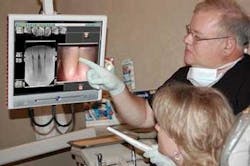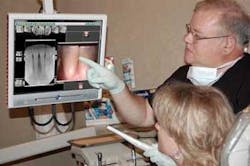X Files #8 — Invest in the future and don't look back!
by Terry L. Myers, DDS, FAGD
For more on this topic, go to www.dentaleconomics.com and search using the following key words: digital radiography, digital imaging, intraoral camera, technology, Dr. Terry L. Myers.
This column offers me an opportunity to show dentists how to become heroes to their patients through different types of technology. More than heroes, successful practitioners must be innovators with the latest equipment for improved diagnosis and increased patient confidence. To help my colleagues improve their future, we took a look at money matters before and after we implemented digital radiography.
We converted from traditional film X–rays to our DEXIS digital radiography system about five years ago. Since then, we take an average of about 16 FMXs a month, 63 individual PAs, and 130 bitewings, totaling about 12,400 different films taken during the past five years. Our digital system eliminated all of the costs associated with maintaining traditional X–rays, such as developing chemicals, processor cleaners, and traditional film.
Over the past five years, the price of chemicals has risen along with the price of gas and groceries. To add insult to injury, with a traditional system, not only do you have to pay for the chemicals, you also have to pay to get rid of them.
In my case, I had to pay at least $30 a month for a responsible hauler to protect the environment and people from my chemical garbage. Besides making life easier for my assistants, I feel like I am investing in the wellness of my staff, patients, and community.
In addition to saving money on supplies, digital imaging allows for shorter appointments. Recently, we conducted a little experiment in our office. We measured the time that it took for one PA: From the time we seated the patient, got the patient ready, and took the digital image, three minutes had elapsed. Since we offer dental assisting classes and need to teach about all forms of radiography, we still own a traditional film processor. We set up the processor and started the same process.
With traditional film, one PA took 10 minutes. Digital radiography surprised us with a seven–minute savings on just one PA. With the extra time, we can comfortably schedule more patients into the workday, and working patients do not have to take off from work any longer than necessary for a dental office visit.
While any new technology requires an investment, the switch to digital radiography did not burden my budget. My system has more than paid for itself. And now — after paying off the machine in about 18 months — I continue to keep my service program, which covers important aspects of my system, such as my sensor, as well as software upgrades and technical support. Any service issues (which are quite infrequent) are quickly addressed and corrected.
With my digital radiography system, I didn't have to make a lot of collateral purchases. With seven operatories and three full–time hygienists, we have operated with one sensor (the sales representative's recommendation) until just recently.
The intraoral camera is another type of technology that facilitates patient education and increases treatment acceptance. We have three DEXcam 3 intraoral cameras that we use for new patients and in the hygiene department. When patients are trying to decide about whether to spend money to fix their teeth, it is great to be able to take a picture of the broken tooth or broken filling so they can see the situation for themselves.
When I am trying to show patients the need for periodontal treatment, I can take a picture of the perio probe with the blood and pus coming up all around it in all of its yucky glory. They may not want to put that photo up on their fridge, but they certainly should realize that this is not something they want happening in their mouth.
Technology has changed the way we do dentistry and the way we do business at Keystone Dentistry. In the recent tough financial times, it is important to avoid stagnation. Let the ideas flow, keep investing in your practice, and move forward. With your new digital technology, you will be equipped to handle more patients as we all start to feel the national economy recover.
Dr. Terry L. Myers is a fellow in the Academy of General Dentistry and a member of the Academy of Cosmetic Dentistry and the Dental Sleep Disorder Society. He has a private practice in Belton, Mo. Contact Dr. Myers by e–mail at office@keystone–dentistry.com.

